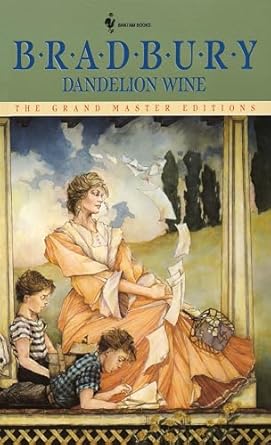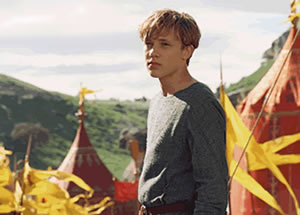To die would be an awfully big adventure.
—Peter Pan
A Modern Myth

Peter Pan is one of the few stories that really qualifies as a modern myth. It has endured for over a century now, and is almost universally known in the English-speaking world. Director P.J. Hogan gives the tale wonderful impetus into its next century with this beautiful and intelligent film version. This is the telling of the Peter Pan tale par excellence, not only because it’s so professionally done, but also it brings out the undercurrents in the tale that have never really been expressed before, foremost of which is that Peter Pan is really a story of first love.
Why is this the first time the love story has been presented in Peter Pan? Because this is the first film version where Peter is played by a boy and not a woman! In addition, Peter has usually been shown as a very young child, which made his terror of growing up feel considerably “off,” not to mention his confused love for Wendy. Hogan rectifies this by showing us Peter on the verge of adolescence. This makes everything—the romance, his fear of growing up, and his mastery of the sword—ring far truer.
While it definitely remains a children’s film, this Peter Pan is neither dumbed-down nor sugar-coated. The dark undertones of Barrie’s original are not glossed over. Peter is not cute and sweet, he’s a young warrior who longs to kill Hook. Mermaids are dangerous creatures. Tinkerbell is funny, crazy, and sometimes murderous.
Flying is presented smoothly and nonchalantly, as though it were the most natural thing in the world. There are no self-conscious interruptions like the “bullet time” in The Matrix. I highly recommend watching the DVD extras which detail the grueling months spent in flying practice and sword training to appreciate what an impressive accomplishment this was.
Wendy’s story
Hogan’s film brings home something else that generally escapes us—that this story isn’t about Peter Pan, but Wendy. Wendy Darling is wonderfully portrayed by Rachel Hurd-Wood, who might be the next Jodie Foster. As the story opens, her Aunt Millicent notices that Wendy is becoming a young woman, and persuades Wendy’s parents to give her her own bedroom, and begin schooling her in the arts that will help her to “marry well.” Wendy must soon stop regaling her brothers with pirate stories, and to start learning to prepare for what Mrs. Darling calls the greatest adventure, love.
On one of the last nights she’ll spend with her brothers in their shared bedroom, she wakes up with a start, to see a half-naked boy floating in the air above her bed, who quickly vanishes. In school the next day, she draws a picture of him hovering over her bed, and her teacher dashes off a note to Mr. Darling regarding his daughter’s “unseemly preoccupations.” (We’re in the Victorian era, after all.)
When Peter returns the next night, Wendy learns that he’s been listening for months to her telling stories to her brothers. Partly, he’s enchanted by the story-telling, but mostly he’s enchanted by her. “One girl is worth more than twenty boys,” he says. When he tells her that the Lost Boys are children who fell out of their prams and went to Neverland, she asks why there are no girls there, and Peter replies, “girls are far too clever to fall out of their prams.”

Wendy is just as entranced by Peter. He’s charming, cocky, slightly surly, and has an oh-so-exotic American accent. She offers to give him a kiss, and Peter holds out his hand to receive it, thinking a kiss is an object. Not wanting to embarrass him, she gives him a thimble, and he reciprocates with an acorn. When she tries to give him a real kiss, Tinkerbell’s dangerous rage comes into play, so that will have to wait. Wendy asks if her brothers can come along to Neverland with her, and Peter agrees, clearly not because he wants to, but because he doesn’t want to disappoint her. (Five minutes later, he can’t remember their names.)
“The Wendy’s” Choice
When Wendy arrives in Neverland, she finds it full of adventure, although she’s unprepared for the level of danger in this world. Tinkerbell tries to get the lost boys to kill this strange visitor she calls “the Wendy;” her plot is foiled only by the acorn “kiss” that Peter gave her, which stops an arrow from piercing her heart. (That “a kiss is a powerful thing,” is a recurring motif.) When Peter finds her, she falls into her role of being mother to the lost boys (and her brothers), with Peter acting as the group’s father.

Peter is enamored with Wendy, and eagerly shares with her all the magic of his world. In one beautiful scene, he shows her a fairy dance inside a hollow tree, and the light from the fairies illumines their faces. Peter and Wendy move away from the tree, and begin to dance themselves, their happy thoughts lifting them into the air, as the fairies circle around them showering them in a golden circle of fairy dust.
Wendy, though, is growing up; she knows that no fantasy can satisfy her forever. She’s seen Peter’s world, but not his heart. Intuitively, she knows that the environment isn’t real, but the heart is. She asks Peter if it’s all just make-believe. He answers, “Yes, if I were a real father, I’d feel so old,” and they begin to spiral down. Wendy presses him to talk about his true feelings; he can relate his feelings of anger and his knowledge of jealousy, but nothing of love. Once his inability to love is exposed, he lashes out:“Why do you have to ruin everything? We have fun, don’t we? I taught you how to fight and how to fly! Go, and take your feelings with you!”
This scene is powerful. It speaks to all the boy-men (and their female counterparts) in the real world who want the benefits of love, sex, and relationship without giving themselves. Although Peter enjoys the feeling of being in love, he can’t give himself in love, which would meaning sacrificing his eternal youth. All real love entails some sacrfice, from the everyday sacrifices of couples to each other and parents to their children, to the profound picture of God’s love in Christ’s self-surrender.
Hook witnesses the scene and senses the enormity of Peter’s mistake, realizing that he is simply an older version of Peter Pan. He acutely feels the ache of having lived a loveless life, and schemes to make Wendy his own.
Wendy is tempted. Hook seems mature, while Peter wants to be a boy forever. With Peter, Wendy can only be a mother, but Hook offers her the more exciting role of piracy as “Red-Handed Jill.” Yet Wendy is able to sense that both Pan and Hook are playing at love, something neither is really capable of. Wendy decides to stop holding on to that which isn’t real, and return to real life, with its possiblity of real love, in London.
Fear of the next step
Peter isn’t the only one afraid, though, he’s simply the most honest about it. Peter is unafraid of death, but fears life—specifically the ordinariness of adulthood. That other lost boy, Hook, is afraid of death and old age. Time is after him and will devour him, symbolized by the ticking clock inside the enormous crocodile. Wendy is afraid of life choices. She’s excited by both Peter’s wildness and Hook’s debonair manners, but knows that both are wrong for her; she must leave Neverland and return to reality.

All fear is really fear of the future in some respect, and it’s often about the next change in our life situation—to put it broadly, about the next part of our “growing up.” This film can disturb you if you watch it openly, because you will likely see some of your own fear mirrored in the those of Wendy, Peter, or Hook. At some level, we all have this hesitancy about that next step in some part of our lives, and mere physical age is no evidence of not stopping in Neverland and refusing to go forward. Neither is having a family; many people go through the motions of development, while freezing huge parts of their lives, very often their spiritual lives, at a childish level. As Jed McKenna wrote in Spiritually Incorrect Enlightenment, “a seventy-year-old is often an eleven-year-old with fifty-nine years of experience.”
Although there’s a happy ending of sorts—Wendy returns home along with her brothers and the Lost Boys, who also now have a home, there’s a profound sadness at seeing Peter turn back from her window to fly back to an emptier Neverland, with no Lost Boys to guide, no Hook to fight, and no Wendy to love. His last words are:
To live would be an awfully big adventure.
It would be, if he took it.
Movie stills © 2003 Universal Studios.






 I’m back from my trip and blogging again. I’ve actually wanted to blog about the tsunami disaster in Asia and Africa for a while now, but haven’t quite been able to. I felt numb just thinking about it.
I’m back from my trip and blogging again. I’ve actually wanted to blog about the tsunami disaster in Asia and Africa for a while now, but haven’t quite been able to. I felt numb just thinking about it.


 Last weekend at
Last weekend at 


